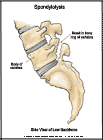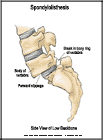
Spondylolysis and Spondylolisthesis
What are spondylolysis and spondylolisthesis?
Your lower back is called your lumbar spine. It is made up of five bones called lumbar vertebrae. The vertebrae have two major parts, a solid part called the body and a bony ring through which the lower part of the spinal cord and nerves travel. Between the bodies of the vertebrae is shock absorbing material called disks. Part of the ring of each vertebra, called the pars, touches the vertebra above it and the vertebra below it.
Spondylolysis is a condition where there is a break in one or both sides of the ring of a vertebra. Spondylolisthesis is a condition in which a break in both sides of the ring allows the body of the vertebra to slip forward. Spondylolysis and spondylolisthesis most commonly occur at the fourth or fifth lumbar vertebrae. These conditions are also called pars defects, pars stress fractures, or stress fractures.
How does it occur?
Spondylolysis and spondylolisthesis result from repetitive extension of the back (bending backward). This causes weakness in the rings of the lumbar vertebrae, eventually leading to a break (fracture) in a ring. Less commonly, these conditions may result from an injury to the back. Some health care providers feel that certain people are born with weak vertebral rings.
Athletes most commonly troubled by spondylolysis or spondylolisthesis are gymnasts, dancers, and football players.
What are the symptoms?
You may have low back pain or spasms, or you may have no symptoms at all. You may have pain all the time or only from time to time. Spondylolysis or spondylolisthesis usually do not damage the nerves.
How is it diagnosed?
Your health care provider will examine your back and look for tenderness along your vertebrae or spasm in the muscles next to your vertebrae. He or she will order an x-ray, which will show a break in the ring of a vertebra or slippage of a vertebra. Your provider may order a bone scan to look for a break that has just recently occurred.
How is it treated?
For periods of acute pain your health care provider may prescribe anti-inflammatory medication or other pain medications. You should place ice packs on your back for 20 to 30 minutes every 3 to 4 hours for 2 to 3 days or until the pain goes away.
You can participate in your sport or activity as long as you do not have pain. You may need to change your sport or activity to one that does not involve hyperextending the back.
If your health care provider thinks the break is new and that the bones could heal, he or she may recommend wearing a brace for one to three months. Severe cases of spondylolisthesis may require surgery.
Spondylolysis and spondylolisthesis are chronic problems. It is very important to keep your back in the best possible physical condition. Do not become overweight.
How can I prevent spondylolysis and spondylolisthesis?
You can best prevent these conditions by having strong back and abdominal muscles and by avoiding being overweight. If you have spondylolysis you may be able to prevent progression to spondylolisthesis by doing back exercises and by avoiding forced back extension activities, such as might occur during tackling in football.


